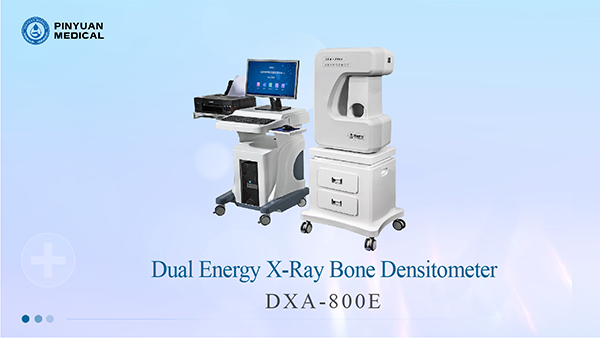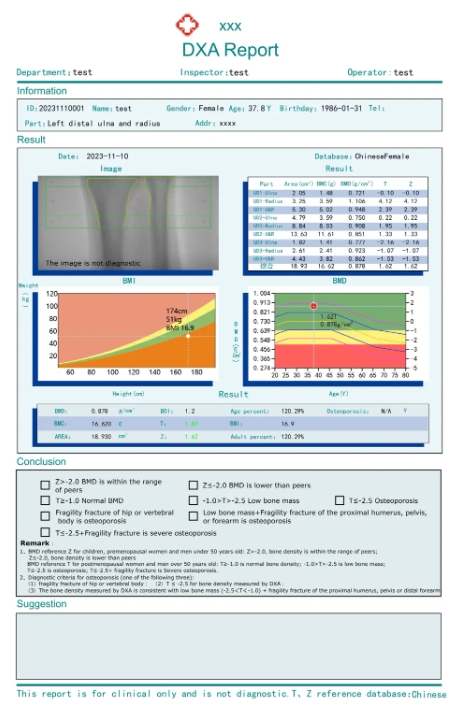In recent years, the incidence of osteoporosis has skyrocketed China's osteoporosis patients have climbed from 69.44 million six years ago to 100 million now, with a prevalence rate of 6.97% The prevalence rate of people over 60 years old is 56%, and it is as high as 60% to 70% for elderly women.
It is expected that by 2050, 51% of people will have osteoporosis. Osteoporosis has become a major disease plaguing the elderly population, the incidence of which has followed diabetes, Alzheimer's disease, jumped to the third place in the elderly disease.
To prevent osteoporosis, please pay attention to the bone density examination.
How is osteoporosis diagnosed?
Diagnosis of osteoporosis mainly relies on the measurement of bone mineral density (BMD), i.e., bone mineral density, is a major indicator of bone strength, measuring how much calcium and other minerals are contained in a certain part of the body at the present time, expressed in grams per square centimeter (g/cm2), which is the current gold standard for the diagnosis of osteoporosis.
Dual-energy X-ray bone densitometry (DEXA) is currently recognized worldwide as a better tool for measuring bone mass and bone density, the main measurement site for the lumbar spine, hip bone density, with accurate positioning, high measurement accuracy, speed and other characteristics, to meet the needs of accurate diagnosis in orthopedic examinations.
Bone density test is safe for human body, it has short scanning time, simple operation, no pain and other characteristics, and combined with other risk factors comprehensive assessment, can predict the risk of fracture of the body in the future.
How to read the Bone Densitometry report and recognize the significance of T-value and Z-value?
I believe that people who have had a bone density test should have an impression of the "T value" and "Z value", and you may think that the meaning of these two values is only to determine whether you have osteoporosis or not. "If so, you're not really sure what you're looking for. If this is the case, you have not really read the full significance of this test. Because, you only know "one‘’but not "two". A bone density test doesn't just tell you a result, it also tells you the truth - “you're losing bone mineral content".
Generally speaking, bone density test results are often given in the form of "picture + table": "picture" visualizes that the examinee's bone density value is located in the specific position of the Chinese male (female) bone density reference curve; and "table" directly shows that the examinee's bone density value is located in the specific position of the Chinese male (female) bone density reference curve. The "table" directly lists the T-value and Z-value.
1.Read and understand "T-value" -1﹤T-value﹤1 indicates normal bone density; -2.5﹤T-value﹤-1 indicates low bone mass and bone loss; T-value﹤-2.5 indicates osteoporosis; T-value﹤-2.5 and history of fragility fracture indicates severe osteoporosis. Note: T-value is a relative value, which is usually used to determine whether the bone density of human body is normal or not. It compares the bone density obtained from the test with that of the healthy young people aged 30-35 years old, in order to derive the number of standard deviations of the young people who are higher (+) or lower (-) than them.
2. Read the "Z value" -2﹤Z value means that the bone density value is within the range of normal people of the same age; Z value ≤-2 means that the bone density is lower than the normal people of the same age; Note: Z value is also a relative value, which is based on the grouping of the same age, same gender and same race, and compares the bone density value of the corresponding test participant with the reference value. Z-scores that are lower than the reference value should be brought to the attention of the patient and the clinician.
A normal Z value does not mean that there is no problem at all. For example, a normal Z value in an elderly person does not mean that he/she is very unlikely to develop osteoporotic fracture, because with the loss of bone mass in the same age group, the bone density decreases, and the brittleness of his/her bones increases further, which is why it is necessary to refer to the T value in order to accurately determine the situation of the bone mineral density.
How can I assess my risk of developing osteoporosis?
One of the most important measures is to keep abreast of the changes in your bone density and then take preventive and protective measures accordingly.
For the following high-risk groups for osteoporosis: (1) elderly people over 65 years old (2) middle-aged and elderly people over 45 years old, especially menopausal women (3) adults with a history of fragility fracture or a family history of fragility fracture (4) adults with a low level of sex hormones and (5) people who are addicted to smoking and alcoholism, it is very important to have a bone mineral density checkup once every 6 months or once a year.
What should you do when -2.5﹤T value﹤-1?
The human skeleton shows the trend of "normal→decrease→looseness", and the golden age of "peak bone mass" will come in adolescence, if the reserve of bone tissue is sufficient at this stage, it can effectively avoid the loss of large amount of bone mass in postmenopausal and old age, and then delay osteoporosis. If there is sufficient bone tissue reserve at this stage, it can effectively avoid the large loss of bone mass after menopause and in old age, and then delay the occurrence of osteoporosis.
If you are already in the stage of bone loss, you should start to "mend". First of all, correct bad habits, smoking, alcoholism, high salt diet and excessive drinking of coffee, strong tea, carbonated beverages and other unhealthy habits tend to accelerate the loss of bone mass; secondly, more sunshine and more exercise, and in the process of dietary choices of calcium and vitamin D-rich foods, such as milk, green vegetables, seafood, fish and beans and so on.
What should you do when T-value﹤-2.5?
Once osteoporosis occurs, there is no way to "mend" it. Research has shown that existing medical interventions are unable to reconnect broken bone trabeculae, which means that the fact of "osteoporosis" cannot be changed. Therefore, for people with osteoporosis, it is imperative to slow down the rate of osteoporosis and prevent fractures from occurring.
If you have been diagnosed with osteoporosis, in addition to adhering to a healthy lifestyle, it does not make much sense to simply take calcium supplements; instead, you should choose the appropriate anti-osteoporosis medication under the guidance of your doctor. In addition, in the process of daily life, you should be careful to prevent the occurrence of bone fracture, once the fracture occurs, you should actively accept the formal treatment, to avoid unauthorized treatment to bring sequelae, and then seriously affect the quality of life of yourself and your family!
Post time: Aug-26-2024


